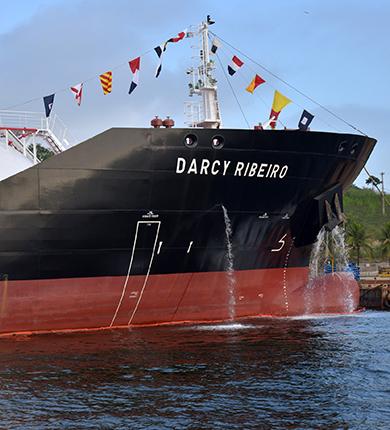The ship Darcy Ribeiro was delivered to Transpetro last Friday (1/7), at the Vard Promar Shipyard, in Niterói. This is the third gas tanker to join the company's fleet in less than a year, being the 15th vessel in the Fleet Modernization and Expansion Program (Programa de Modernização da Frota - Promef) to enter into operation. The first trip by the gas tanker Darcy Ribeiro will be to the Barra do Riacho Waterway Terminal (Terminal Aquaviário de Barra do Riacho - TABR), in Espírito Santo, where he will schedule loading for the port of Fortaleza.
Darcy Ribeiro is the 56th vessel to compose the Transpetro fleet. With a capacity to transport 7 thousand m³ of Liquefied Petroleum Gas (LPG), the vessel is prepared to operate in all regions of Brazil and in South America.
The growing number of modern vessels makes it possible to improve logistics efficiency for the flow of Petrobras production.
Technical data of the ship Darcy Ribeiro:
Type: Gas Tanker
Transport capacity: 7 thousand cubic meters
Total length: 117.63 meters
Width: 19.20 meters
Height: 34 meters
Draft: 5.80 meters
Moulded depth (distance between the bottom and the deck): 8.60 meters
Speed: 15 knots
Autonomy: 11 thousand nautical miles
Number of tanks: 2 (two)
Types of ships
Gas carrier - type of vessel built to transport liquefied petroleum gas. It is primarily intended for coastal shipping.
Panamax - oil tanker for the transport of crude oil and light and dark products. The loading capacity is in the range of 65 thousand to 80 thousand tons of deadweight (DWT). Similar in size to those that pass through the locks of the Panama Canal.
Suezmax - oil tanker for the transport of crude oil. The loading capacity is in the range of 140 thousand to 175 thousand deadweight tons (DWT). This vessel meets the limitations of the Suez Canal in Egypt: width of 48 meters and draft of 17 meters.
Products - oil tanker for the transportation of petroleum products, such as diesel, naphtha, gasoline, fuel oil and aviation kerosene. The loading capacity is in the range of 30 thousand to 50 thousand deadweight tons (DWT). It is primarily intended for coastal shipping.

